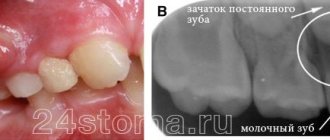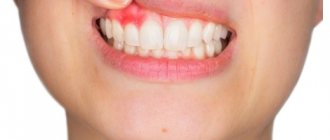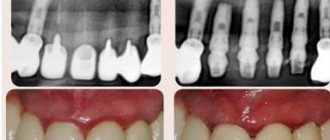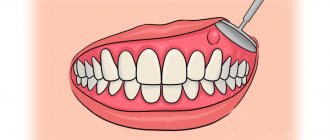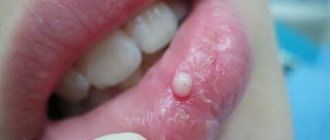Why do ulcers appear on the gums, and is it always dangerous?
There are many possible reasons. To understand how dangerous the appearance of certain lesions on the gums is, you need to look at additional accompanying symptoms:
- in case it is trivial mechanical damage. The gums can be damaged by hard food, a toothbrush, or a foreign object. These lesions may resolve in 3-5 days. If a person does not brush his teeth, then infection is added to these damages, and healing may take several weeks.
- Sometimes ulcers can appear as a result of wearing orthodontic structures, braces or removable dentures.
Why do gums swell?
Have you noticed that your gums are swollen and red? Do you experience unpleasant sensations or discomfort when chewing food? There may be several factors and it is best to consult a doctor. The beauty, health and even safety of teeth depends on the correct and accurate diagnosis at the first symptoms of gum swelling.
Method of conservative treatment of gums using the “Vector” system
Dentists at the Zdorovye clinic identify several causes of gum swelling. This could be a trivial minor injury to the oral cavity: for example, when using a toothpick carelessly or chewing a bony fish too vigorously. Even the crust of bread can be the culprit of a microscopic scratch. If an infection gets into the wound, the gums become inflamed and swollen. As a rule, this does not lead to dire consequences, but the patient cannot always assess the cause and stage of inflammation. Unlike a doctor, who with a trained eye will determine the source of discomfort and the best solution to the problem.
Another common example of mechanical damage is gum burn. It can be chemical (using aggressive liquids) or thermal (hot tea). The gums swell, change color, and sharp, painful sensations appear. As a rule, redness in such cases goes away within a day, and a white film appears in its place. Swelling of the gums may last a little longer. At this moment, it is important to quickly and competently heal the wound on the mucous membrane, preventing the development of serious complications that can damage the tooth.
Finally, the third and most serious cause of gum swelling is true inflammation of the oral cavity due to gingivitis or periodontitis. In this case, the swelling is accompanied by severe bleeding of the gums and its redness. This is a secondary sign of a problem that requires immediate attention to the dentist. With the development of severe stages of periodontitis, the infection can spread to adjacent teeth and bone, leading to tooth loss. To prevent this, periodontists at the Zdorovye clinic select individual treatment in each case. At the first signs of gum swelling, it is very important to correctly determine the root cause of the problem. For an accurate diagnosis, the patient is given an x-ray, based on which the dentist assesses the severity of the inflammation. At an advanced stage, surgical intervention may be necessary - curettage of periodontal pockets or flap surgery. But, as a rule, doctors try to limit themselves to therapeutic methods: removing soft plaque and tartar, selecting anti-inflammatory drugs, applications to the gums and medicated toothpastes.
The most common diseases of the oral cavity in which ulcers appear
- ulcerative necrotizing gingivitis. The cause of this disease is bacteria that multiply when immunity decreases. Extensive ulcers appear on the gums, regional lymph nodes become enlarged, and the temperature may rise
- chronic recurrent aphthous stomatitis. Up to 4-5 white spots first appear in the mouth, which later turn into ulcers. There is no temperature or other problems related to well-being. If such symptoms appear 1-2 times a year in small quantities, then there should be no cause for concern. Frequent occurrence is associated with weakened immunity and possible intestinal diseases, as well as allergies.
- acute herpetic stomatitis. Herpetic stomatitis occurs in a child when he first encounters the herpes virus. Many bubbles appear on the gums, which, after bursting, turn into ulcers that merge with each other. The gums are always bright red, and the ulcers themselves are very painful, the temperature may rise
Thermal burns
The most common injuries to the oral cavity are household thermal burns of the gums and mucous membranes. Each of us has received similar damage at least once in our lives: a careless sip of too hot coffee, and now we are suffering from unpleasant symptoms:
- blisters and bubbles filled with liquid appear on the gums;
- the gum surface becomes rough;
- bothered by continuous aching pain, which intensifies when touching and eating food;
- dryness may occur.
Contrary to common misconceptions, severe thermal burns are very dangerous for gums and can lead to disastrous consequences. Dentists distinguish several stages of development of a thermal burn:
- The gums turn slightly red and recover quickly. The patient feels almost no pain and, if desired, can quickly cure such a gum burn at home.
- Blood rushes to the gums, the tissues begin to darken, swell, some areas become white, and become very hot. Blisters appear on the surface of the gums.
- The mucous membrane is significantly (sometimes almost completely) hidden under blisters and is severely damaged. The pain becomes unbearable. Immediate medical intervention is required.
- The gums bleed profusely and become covered with flaps extending from the bone. The patient's jaw base is exposed, and there is a high risk of developing necrosis.
In more than 90% of cases, gum burns received in domestic conditions are first and second stage injuries. In such cases, fortunately, hospitalization is not required, and the discomfort can be relieved with pharmaceutical products.
Chemical burns
Another common type of injury to the oral cavity is a chemical burn to the gums, which occurs as a result of taking various medications and reagents.
Dental burns
A common type of chemical burn is injury to the gums during whitening with special compounds and polymers and dental treatment. Inattentive doctors can violate the application technique, and then drops of solutions and compositions will fall on the gums and burn the delicate mucous membrane when treating tissues with a UV lamp.
Dental chemical burns to the gums are particularly dangerous injuries. Such injuries are characterized by rapid development of deep wounds and death of soft tissue.
Work injuries
Employees of hazardous industries or finishing workers also suffer from chemical burns to the gums. Injury can occur both through contact with acids, metal salts and alkalis, and through their careless use.
Domestic injuries
Unfortunately, most often children who suffer from chemical burns to their gums are drawn to taste household chemicals. Some adults also suffer chemical injuries when they decide to try unlicensed gum supplements, medications, soothing agents, or toothpastes from unknown manufacturers.
Symptoms of chemical burns
Chemical burns to the gums do not manifest themselves in exactly the same way as thermal burns. This type of injury is characterized by the following manifestations:
- voluminous blisters on the gums;
- swollen tissue;
- severe pain, itching.
How to treat burns?
Gum burns are very unpleasant injuries. A person immediately feels a sharp pain, which can spread to the roots of the teeth and temples. It becomes difficult not only to eat food, but also to swallow saliva. The tongue constantly probes the rough surface and swollen areas. Many people note an unpleasant metallic taste in their mouth.
First aid
First aid depends on the type of gum burn. In case of domestic injuries, you must act according to the following scheme:
- First, rinse your mouth thoroughly with clean water. Thus, the patient removes food debris and reduces the temperature. There is no need to swallow the water; a new portion should be taken after a minute. Some patients are helped by “freezing” the nerve receptors with pieces of ice.
- Then the mouth can be rinsed with antiseptic preparations. An excellent healing agent for household injuries, including burns of the gums, is Asepta Active oral skewer. This remedy combines a combination of the anti-inflammatory, analgesic component benzydamine and the antimicrobial component chlorhexidine. This complex provides the antiseptic effect of the skewer while simultaneously relieving inflammation and pain, which increases the effectiveness and quality of tissue treatment.
- If desired, the burned area can be treated with sea buckthorn oil and rinsed with furatsilin solution or chamomile decoction several times a day.
Treatment of chemical burns to the gums should be entrusted to a dentist. Such injuries require maximum care and caution. Substances can react even with ordinary water and cause inflammation.
For chemical burns of the gums, self-therapy is strictly not recommended. If the treatment is incorrectly selected, the patient may develop a fever and experience throbbing pain in the burn area. In advanced cases, people experience swelling in the throat and swallowing becomes difficult.
In each specific case, the dentist develops individual therapy:
- For acid burns of the gums, rinsing with alkaline solutions (for example, water with 1-3 drops of ammonia, apple cider vinegar or a pinch of baking soda) is prescribed.
- If the burn is caused by phenol, doctors prescribe ethyl alcohol and castor oil dissolved 1:1 with water as treatment.
First aid
If the temperature rises, you can take an antipyretic drug. In the future, before visiting a doctor, nothing should be done. Do not take antibiotics yourself or try to get into the ulcer with any object.
How to relieve symptoms of ulcers
- do not eat sour and salty foods
- food should be warm, no hot dishes or drinks
- Care should be taken to ensure that the child does not put dirty hands in his mouth
- teeth should be brushed, but make sure that the bristles do not touch the gums with ulcers
- It is recommended to rinse your mouth with herbal solutions (oak bark, chamomile) 3-4 times a day
You should be careful when using antibacterial solutions. They must be prescribed by a doctor. If such solutions are used incorrectly, they can provoke the development of thrush. The antibacterial agent will “kill” the beneficial microflora, which can result in a fungal infection.
Prevention of ulcers
- professional oral hygiene at least 2 times a year
- Regularly replacing your toothbrush
- Proper brushing of teeth at least 2 times a day
- using additional hygiene techniques such as irrigators, dental floss, and tongue scrapers
- Children should be monitored for bad habits such as putting dirty fingers and other objects into their mouths
- It is important to treat your teeth in a timely manner. Microbes that are found in carious teeth and rotten roots can serve as a source of infection for ulcers
If you have problems in the oral cavity, contact the specialists of the Center for Family Dentistry!
Causes of bumps
The formation of lumps on the gums causes an inflammatory process of soft tissues, as a result of which pus accumulates in the thickness of the gums, forming noticeable swelling. This suggests that the disease that caused the inflammation has reached an acute stage and is progressing. The most common reason for developing pus-filled or hard bumps on the gums is poor oral hygiene. But there are other sources of inflammation on the gums that a dentist can identify:
- Gingival fistula - swelling has a diameter of 3-6 mm with a white tip on the surface (an outlet for purulent contents). May be located above or below the tooth. If a fistula on the gum is not treated in time, the acute process of inflammation can become chronic.
- Periodontitis - looks like a compacted swelling; patients describe the problem as “a hard lump on the gum.” The diameter of the formation can be up to 1 cm and does not cause pain. Hard lumps appear as a result of pulpitis or unfilled teeth. If the purulent focus is not eliminated in a timely manner, it will lead to a granuloma or cyst.
- Gingivitis is a disease caused by insufficient oral care. It manifests itself as slight swelling and redness of the gums with bleeding. Therefore, the formation is often called a “red bump on the gum.”
- Periodontitis – gum tissue becomes inflamed due to the accumulation of bacteria in the gum pocket. Which, in turn, forms between the loosened tooth and the gum. Bacteria cause a purulent process and swelling in the form of a whitish lump.
- Epulis - develops as a result of mechanical trauma to the gums (unsuccessful filling, uncomfortable prosthesis, sharp edges of neighboring teeth, etc.). Globular swelling on the leg (mushroom-shaped) has a bluish tint and can reach a considerable size - up to 2.5-3 cm. Most often it affects the lower jaw and is most common among women. It can also affect the gums of children when teething for the first time.
- Hematoma - may appear after injury during tooth extraction. The swelling is watery in appearance, usually soft to the touch and may be slightly painful.
